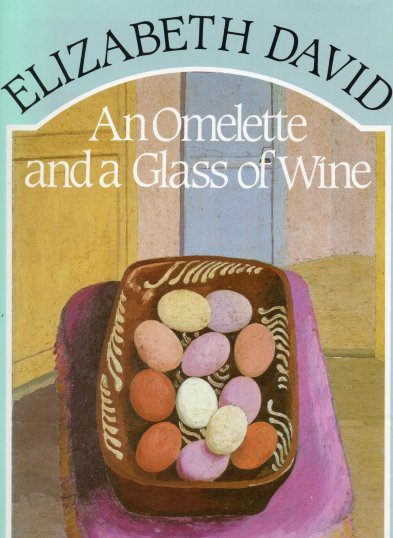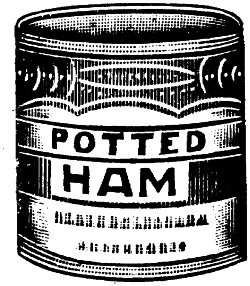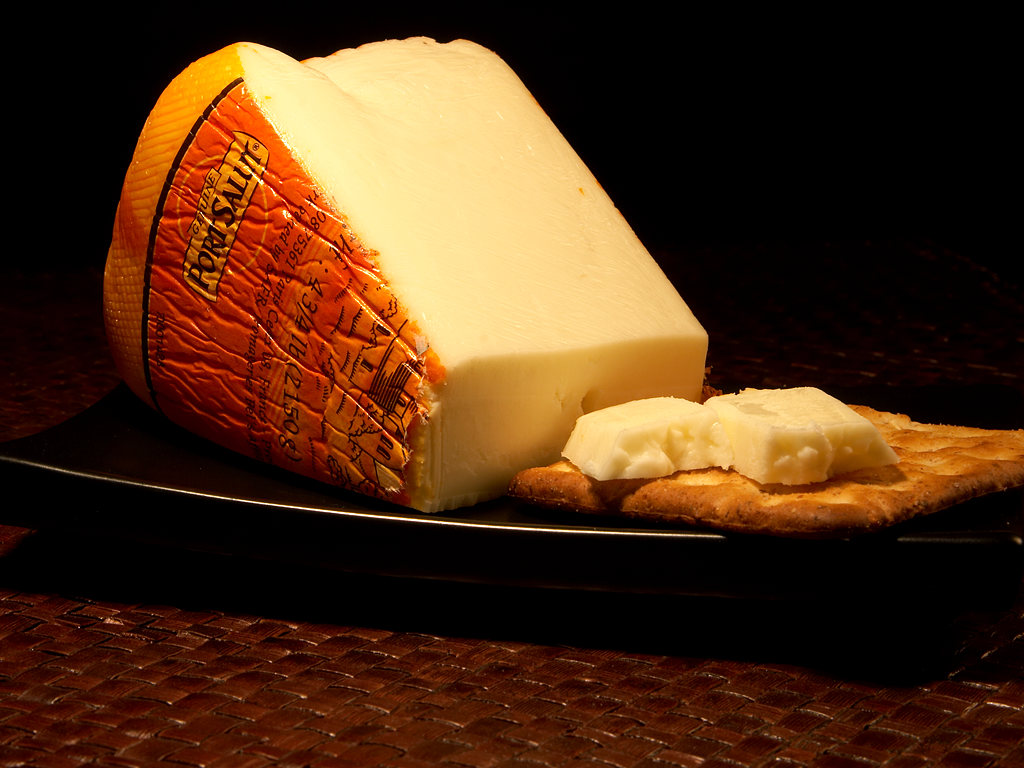Pizza Delivery
Thoughts on Elizabeth David, an interwar French genius in London, “Chopped,†the power of memory, ill-chosen cherries, multinational rabbits and molten cheese, inspired by another pair of pizza deliveries.
 In our Elizabeth David Number, the Editor disclosed that her favorite books by David are English Bread and Yeast Cookery and An Omelette and a Glass of Wine, the compilation of shorter articles that David wrote for The Spectator and other publications between 1952 and 1984. David fretted over republishing the essays lest it indicate to the chattering classes that her powers had diminished, but the accolades surfed right in. The engaging compilation not only enhanced David’s reputation but also introduced a larger North American readership to her work, which always had posted good sales figures in Britain. Twenty-six years after publication, An Omelette remains essential reading for anyone with a serious interest in twentieth century foodways.
In our Elizabeth David Number, the Editor disclosed that her favorite books by David are English Bread and Yeast Cookery and An Omelette and a Glass of Wine, the compilation of shorter articles that David wrote for The Spectator and other publications between 1952 and 1984. David fretted over republishing the essays lest it indicate to the chattering classes that her powers had diminished, but the accolades surfed right in. The engaging compilation not only enhanced David’s reputation but also introduced a larger North American readership to her work, which always had posted good sales figures in Britain. Twenty-six years after publication, An Omelette remains essential reading for anyone with a serious interest in twentieth century foodways.
Not that An Omelette is infallible, or even reliable in its instruction. In all of her books, David was wont to publish recipes that she did not cook, let alone taste, and her habit frequently fails her readers. Some of the recipes, as we previously have demonstrated, are absurd on their face. Others, however, including the ones she reproduced from the work of Marcel Boulestin, are brilliant both in flavor and simplicity. Boulestin was one of the few heroes whom David worshipped. He is a compelling and even thrilling figure, a French patriot and veteran of the Great War who traveled to England, then fell in love with the country and its food at a time when the French did no such thing. Boulestin considered himself a cultural citizen of both countries but did spend most of his later years in London where his Covent Garden restaurant remained a landmark for decades.
Boulestin’s radical culinary notion was the simple preparation of pristine ingredients. That may sound altogether conventional at this remove but entailed radicalism when he practiced it between the world wars. Elaborate presentations of heavily sauced foods may have dominated fashionable restaurants and the dining rooms of the rich, but not the kitchen of Boulestin.
He anticipated by several years the ‘omelet Arnold Bennett’ that the Savoy Hotel ‘invented,’ by cooking eggs with smoked haddock, and by serving such simple fare as something special. As David explains,
“in those days only Boulestin thought of actually inviting people to lunch to eat scrambled eggs. It goes without saying that he did not serve scrambled eggs with smoked haddock, he cooked the haddock first, flaked it, and mixed it with the beaten eggs before cooking them. He added a little cream to the finished scrambled eggs and put fried croutons around them.” (Omelette 169)
Along with a green salad and spoonfuls of grated Cheddar or Parmesan stirred into the eggs before the haddock, what could be better with a glass of Alsatian Riesling? There must have been bread too, maybe even toast if Boulestin went in for the Full Anglo.
When David discusses Boulestin and his food, her bossy style softens a bit, and if she hectors her readers all the same, we do not mind. She is the opinionated professor whose judgment we may not trust but who intrigues us with her stern passion.
In a particularly good essay, “English Potted Meats and Fish Pastes,” David picks up on Boulestin’s theme. She originally published ‘Potted Meats’ as an ephemeral pamphlet in 1968, and predictably enough it has become collectable. In it she has reached the height of her powers and gives her reader considerably more than a collation of recipes.
David had a tendency, particularly in private, to denigrate other food writers and in public to seize credit where it was not due. Here, however, she is in generous mode, and applauds a predecessor for tending the flame of a discredited English foodway. She begins by recounting the fact that in 1946 the Wine and Food Society sent new members its quarterly magazine and a little pamphlet along with their membership cards. In the tradition of Georgian cookbooks, the little pamphlet bore a long name. It was called “Pottery, or Home Made Potted Foods, Meat and Fish Pastes, Savoury Butters and Others” by ‘A Potter.’
The potter could write, and evidently enjoyed his subject. David quotes him recalling breakfast with his grandmother: “Neat  little white pots, with a crust of yellow butter suggesting the spicy treat beneath, beef, ham or tongue, handiwork of the second or third kitchenmaid…. ” It is equally evident from this that the potter was far from impoverished despite the homely food, but in uncharacteristically practical mode David reminds her reader that the food processor stands in nicely for both second and third maid as an instrument for the production of potted foods. This was noteworthy at the time, for in 1968 processors had only just appeared, and the gadgets incited mistrust in the customarily minded.
little white pots, with a crust of yellow butter suggesting the spicy treat beneath, beef, ham or tongue, handiwork of the second or third kitchenmaid…. ” It is equally evident from this that the potter was far from impoverished despite the homely food, but in uncharacteristically practical mode David reminds her reader that the food processor stands in nicely for both second and third maid as an instrument for the production of potted foods. This was noteworthy at the time, for in 1968 processors had only just appeared, and the gadgets incited mistrust in the customarily minded.
Potted foods are the traditional pates and terrines of England, made by pulverizing a meat or fish or two or even cheese, engulfing the product in highly seasoned clarified butter (cayenne and especially mace appear to be indispensible) and preserved under that crust the potter described. For some reason the process gives a boost of intensity to whatever you pot, so that if you like beef you will really like potted beef, and so forth.
In another illustration of the intellectual breadth and depth of a certain segment of English society once upon a time, the potter turns out to have been a Major Matthew Connolly. He became interested in snails during a tour of duty in South Africa and went on to publish some fifty learned essays on mollusks. Specimens that he gathered remain in the collections of the Natural History Museum (London), Manchester Museum and National Museum of Wales.
The major was not just an officer, conchologist, malacologist and epicure with epistolary skill; he was father to Cyril, the erudite and legendary (if underachieving) editor of Horizon. The magazine was the literary as well as artistic lodestone of wartime Fitzrovia and its editor consorted with everyone from Auden to Bacon and Freud.
If “Pottery, or Etc, Etc.” was both delightful and instructive, it also failed in its mission to revive interest in potted foods, and for good reason. Returning to sterner form, David warns us that
“these very English store-cupboard provisions… demand first-class ingredients and a liberal hand with butter. It is indeed essential to understand that the whole success of the recipes described in this booklet depends upon these factors, and upon the correct balance of the ingredients.”
So we are back to Boulestin, but not quite, not in 1946, but maybe after 1968 thanks to David. If potted foods require the freshest and best, then scarcity rendered them a nonstarter. Well after the end of rationing in 1954, the British understandably “associated fish paste and potted meat with the fearful compounds of soya bean flour, dried egg and dehydrated onions bashed up with snoek (an inedible canned fish) or Spam” urged upon them by the Ministry of Food under ‘cheerful’ names like “‘mock crab paste’ and ‘meat spread.’”
Poor Major Connolly; as David concludes without a trace of glee, the “Wine and Food Society’s propaganda in favour of home-made potted meats and fish was premature” even if well-intended and even welcome.
David’s “English Potted Meats” eventually would help return this neglected food to its rightful place in the gastronomic constellation, and the elegant essay remains one of David’s rare paeans to English cuisine. It also presents an array of sound and simple recipes that would set both Boulestin and the major to smiling.
When, however, she is bad, David is very, very bad. Back when the Editor accepted anything on trust, she would suspend disbelief and try any recipe, however unpromising in print, offered by a luminary like David. Surely she knew best, and if the juxtaposition of ingredients sounded strange, or the technique suspicious, the opinionated professor probably knew best.
Readers know where the story goes. If the teacher turned out to be Christopher Hill and his acolytes, even the avuncular Edward Thompson, they made things up; something about ends justifying means, the sanctity of labor and all that. They may have destroyed our faith in oracles and dented any glimmer of trust for Marxist history, but we loved them all the same. These people fought for the good guys and they cared. They also inadvertently taught something priceless; we began a reflexive scurry to the footnotes of every text, however ‘trusted,’ to take nothing for granted and to test it all.
So with David. In an early waste of groceries, the Editor destroyed a set of ingredients that could have been assembled by one of the more sadistic producers of “Chopped.” For the uninitiated, “Chopped” is the idiotic and addictive FoodTV program that ‘challenges’ contestants to fabricate something edible out of inharmonious ingredients like cotton candy, stinkfruit and sardines. This is NASCAR enlivened by the delicious certainty that multiple cars will crash.
The hapless cooks present their concoctions to a panel composed of celebrity chefs and eye candy. They can improve the drama by competing on  behalf of a mangled loved-one, dying relative or adorable child, and it helps ratings if one of them cries. It also helps if contestants turn on each other, or fail to finish, or forget a stipulated ingredient. Viewer ecstasy ensues when a judge finds a hair in her food or pronounces the sheep’s balls underdone. In that case, you’re certain to be ‘Chopped!’
behalf of a mangled loved-one, dying relative or adorable child, and it helps ratings if one of them cries. It also helps if contestants turn on each other, or fail to finish, or forget a stipulated ingredient. Viewer ecstasy ensues when a judge finds a hair in her food or pronounces the sheep’s balls underdone. In that case, you’re certain to be ‘Chopped!’
In our case the composition involved Port-Salud, beer, butter, cayenne and the clincher, kirsch, from David’s recipe for ‘French Welsh Rabbit.’ The list itself invoked a madeleine moment in the Editor and required a certain suspension of disbelief.
Once, back in the sunny time of listening in thrall to lectures by the selfsame Edward Thompson, the Editor journeyed to Short Hills, New Jersey, in the company of a classmate who would someday chronicle the copulations of Norman Mailer and Henry Miller (but not with one another). The classmate would achieve considerable acclaim, but all of that lay ahead. In the moment parents were away and the dual attraction of the opulent house lay in the opportunity for unabashed freeloading along with its proximity to the fleshpots of New York City, and in particular bars serving the underaged.
We have found that irrational enthusiasm sometimes takes hold of young adults after the consumption of a case or so of Miller High Life, and so it ensued. On a rare domestic evening three of us persuaded a local worthy to buy the perquisite cases of beer on our behalf, which proved to be a useful supplement to the unprotected liquor cabinet. Its contents helped spur our creativity in the kitchen.
A few lamb chops liberated from the freezer and other food foraged from the house of our unknowing hosts promised a free feast, but alas for the Editor their daughter decided that her chops deserved a special splash of kirsch. This was as good as trying to eat anchovies bathed in cough syrup. Acrimony erupted all around and, in the Editor’s case, hunger at the hands of the delinquent daughter, who never was very nice anyway. The Editor should have known.
Kirsch is nasty enough on its own, and becomes a singular impediment to the flavor of proteins unless your tooth is sweet. But despite the immediacy of memory, the recipe was David’s (but, it turns out, not) and therefore worthy of respect; hope again the nemesis of experience. As any sentient being ought to have instinctively sensed, something called ‘French Welsh Rabbit’ cannot be good to eat. The probability of cultural confusion is simply too great.
You do not even get toast in David’s recipe. She was, of course, Francophile, and since they do not believe in toasters, she fries the bread for this rabbit instead, which increases not only the labor involved but also the calorie count. Otherwise it is enough to say that the dish is as bad as it sounds.
David herself notes in the recipe that “[y]ou can’t grate Port-Salut,” normally a foundational procedure in making rabbit; you need to slowly heat the cheese in a double boiler instead, and despite David’s assurances, Port-Salut is easier to rubberize than to ‘turn creamy’ during the process.
 It turns out that David found the French Welsh rabbit in what she describes as “a leaflet publicizing Port-Salut cheese.” Maybe David was celebrity struck; she confides that the recipe purported to be written by “Comtesse Mapie [sic] de Toulouse-Lautrec,” but how many countesses actually cook? It is more than honorable to infer from her text that David did not cook this rabbit either; instead she made fondue. So why call it rabbit? The object of the advertisement was of course the sale of Port-Salud, the year was 1964, and the ‘countess’ must have assumed that ‘her’ target market was as unfamiliar with fondue as it was with Port-Salut.
It turns out that David found the French Welsh rabbit in what she describes as “a leaflet publicizing Port-Salut cheese.” Maybe David was celebrity struck; she confides that the recipe purported to be written by “Comtesse Mapie [sic] de Toulouse-Lautrec,” but how many countesses actually cook? It is more than honorable to infer from her text that David did not cook this rabbit either; instead she made fondue. So why call it rabbit? The object of the advertisement was of course the sale of Port-Salud, the year was 1964, and the ‘countess’ must have assumed that ‘her’ target market was as unfamiliar with fondue as it was with Port-Salut.
This flogging of so decidedly inauthentic a dish entails a certain irony; elsewhere in An Omelette David rails against “anybody depraved enough” to “sell a pizza as a Welsh rabbit and a Welsh rabbit as a Swiss fondue or a quiche lorraine.” (Omelette 25)
Jane Grigson’s recipe for potted cheese appears in the practical. We also list lots of good rabbits there but the Comptesse Mapie de Toulouse-Lautrec’s French Welsh Port-Salut Rabbit Rendered by Elizabeth David does not appear among them, even though the suitably aristocratic length of its name might inspire a rare gift of Grace & Favour from a wistful crown.
Note:
- In fairness, the Comtesse was a respected food figure who, among other things, edited an edition of Larousse Gastronomique. That ,however, begs the question why the noblewoman had decided to shill for a cheese company.

